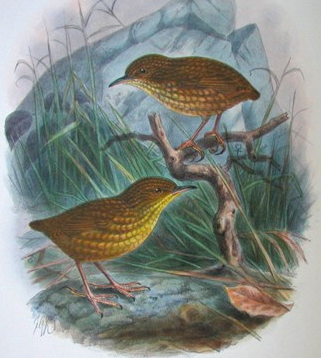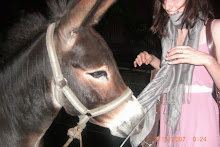skip to main |
skip to sidebar
Probably my favorite story of the extinction of a species is the Stephens Island Wren. Stephen's Island is a tiny uninhabited island off of New Zealand until a lighthouse was built there in the 1894, and a single lighthouse keeper and his cat, Tibbles, lived there. A few months after the lighthouse opens, the lighthouse keeper, David Lyall, sound a small, flightless, bird that Tibbles had caught and killed. It was unlike any bird he had seen before, so he sent it to a scientist friend to look at. The scientist determines that it is a new species, and sends it off to London to be examined and a lithograph to be drawn. Meanwhile, Tibbles keeps on killing more of these little birds - 15 in total. A few months later, Tibbles stops bringing the birds home, and that's the end of that.

No one ever saw the bird alive in the wild. There were probably more than just the 11 that Tibbles nabbed, but Tibbles and his friends have been breeding, and by then there are lots of feral cats running around the island that probably ate up the other few wrens. Before cats came to the island, there were no predators, and the birds had evolved to loose the ability to fly, and took up more of the niche that mice or small rodents would have filled. Living without predators probably also meant they had lost their fear of potential predators. What a sad fate for a tiny creature - to die of being too trusting and having became too slow and comfortable in their prelapsairan secluded life.
When I went with Josh Stein on a trip to the Harvard Museum of Comparative Zoology for an appointment with someone in the orinthology department for some research on dalmatian pelicans, I asked if they had a specimen of the Stephen's Island Wren. The idea of seeing something so rare that there were only ever 15 specimens ever felt exciting. After opening a few drawers of tanengers, the ornitholgist remember that the bird had recently been moved to another draw, but he couldn't remember exactly where. Not wanting to be a pest, I dropped it.
This photo is of the specimen in a New Zealand museum:

So the short version is that i came into posession of a parakeet this weekend that died the next day.
in the living years:

RIP, Josh. The long version is that Eric's brother, Josh, found a parakeet sitting under his parked car in Greenpoint. He called Eric, who was with me, to have me come pick the bird up, because he knew I happened to have a spare bird cage (a decorative antique one - a birthday gift from Eric). It was assumed that the parakeet escaped from the apartment building on his block, and he and his grilfriend Laura planned on putting up "found pet" signs in the builing.
I was thrilled. I took the lil fella home and fed him some of Amy's hamster's food, which he hungrily ate and some water. At night, I put a blanket over his cage to put him to sleep. In the morning, I woke him up, and he adorably had groggy sleepy eyes he kept half-closing. Even though I knew I might have to return him to his rightful owner, I named him Josh after the man who found him. I was in love.
The day was spent out at Coney Island, and when I returned in the evening, Josh was face-down in the cage, competely still.
Insert Monty Python dead parrot joke here.
There was an exciting article on tuesday's science section about researchers finding new dodo remains, as well as more information on how the dodo might have lived before it became extict sometime in the mid 1600's. Boy, was I excited about this. I've really had dodos on the mind recently. A few weeks ago, I was riding with Amy and Micky along the bike path near the south street seaport on an ill-fated plan to visit Govenor's Island, and I was thinknig about dodos, since I had just gotten a new book about excinct birds that morning. Then, all of a sudden, I see this tiny resturant called The Dodo.
Clearly, this is going to be my favorite resturant EVER. Dodo Cafe
Anyway, in the NY Times article, it mentions how dodos are part of the pigeon family, and how their closest relative was the solitaire bird, which is also excinct and lived on a nearby island.

I had never heard about the solitaire bird before. a little internet research led me to some information about the closest living relative of the dodo and the soliatire was the Nicobar pigeon:

That bird is fantastic!!!!
As summer has rolled around, I'm not the only one to feel the itch to get out of the city for a day trip on the weekends. Amy, Micky, Paul, and Eric agreed to join me on a birding trip to the Jamaica Bay wildlife refuge in Queens. I think I was most thrilled about the sweet bastketball jersey that Paul was sporting with his cutoff jeans shorts. He was going on a date later that night, and I really wanted him to wear that outfit to impress the lady.
Jamacia Bay is all the way past JFK airport, in the middle of the bay between JFK and the Rockaways. It's a huge refuge and apparently one of the big spots in New York state for shore birds. Paul and Eric were very worried about the sign that advised to watch for ticks. I warned them that ticks smell fear. Also wusses.One of the first things we saw was an osprey nest on a man-made pole specifially for osprey nests. I recognised these poles from the Felix Neck refuge in Martha's Vineyard, though I don't think I ever actually saw any ospreys at their nests there. But at this best, there were two adults flyign to and from the nest, and as we saw through our binoculars, at least two little baby ospreys. It was pretty far inthe distance, and even with the binoculars, it was hard to see, but the telltale white marks on the head were visible. Paul wasn't convinced that it was realyl an osprey, and suggested it was instead a loon after conferring the guide book.
Thankfully, just then a parks service ranger walked up to us with a giant scope and tripod, and asked, "looking at the ospreys?" He told us that the ospreys were rebounding in population from a few decades ago, and they nested here for a while on their trek up and down the Altantic coast. For some reason, I had thought ospreys were a little more rare, and felt slightly disappointed to know they weren't such a big deal to see.

We saw several sandpipers, which I was unable to idenify, as well as a seagull which gave me some confusion. It looked like a little gull or a bonaparte's gull becuase of its black beak and black feet, but mostly white body. I ended up decided that it was an immature Laughing gull, but to be honest, I'm not erally sure. I couldn't get all its features to match up to any of the images in my guide book, but since gulls look different at different times of year and at different ages, it's hard to tell. I need a better guide.
Paul on the hunt for ospreys, looking fly in his jersey:

I was pleased to see some american oystercatchers, black skimmers, a great blue heron, snowy egrets, gret egrets, and cormorants. I was especially happy to get a good look at some glossy ibises. We left tick-free and satisfied. Paul was abel to make it home in time to change for his date.










